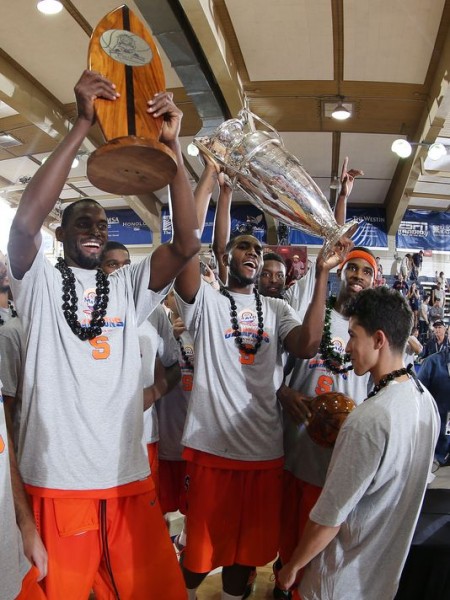Syracuse’s Maui Title Speaks to Roster’s Versatility
Posted by Lathan Wells (@prohibitivefav) on November 29th, 2013When you think about Syracuse, you automatically think about the zone. The Orange’s 2-3 zone defense has confounded opponents throughout Jim Boeheim’s tenure, and its uniqueness across the college basketball landscape makes it that much harder to prepare for. One of the keys to the zone is that there often appears to be holes, places for a team to look to operate with space. Instead, the length of the Syracuse defenders closes those holes quickly and converges on opponents with a tenacity that can make even the most seasoned teams struggle. This year’s Orange team, at least thus far, has operated as a sort of microcosm of its preferred method of defense. There appear to be weaknesses to exploit, and sometimes teams have had success doing so. But in the end, Syracuse, just as its vaunted 2-3 zone often does, has won, including hoisting this year’s Maui Invitational trophy on Wednesday.
Coming into the year, the team was concerned about replacing its perimeter core. Point guard Michael Carter-Williams, guard Brandon Triche and swingman James Southerland all left, either via graduation or early draft entry, leaving the team unseasoned on the outside. One of the keys was the development of shooting guard Trevor Cooney. Billed as a shooter coming out of high school, he’d failed to live up to expectations for the Orange early in his tenure. But Cooney has shown that he can explode at times, with a 27-point, seven three-pointer effort in the opener versus Cornell, five made triples against Minnesota in the opener of the Maui Invitational, and another 23 points against California in the semifinals of the same tourney. The problem is that at other times he’s been a non-factor, such as when he was 1-of-6 from the field in a win over Fordham or 1-of-5 from the arc against Colgate. Cooney’s consistent ability to stretch defenses with his perimeter game is a must for this team.
Tyler Ennis arrived with lofty billing to be the next great Syracuse point guard, trying to replace the prodigious talents of Carter-Williams. A freshman, Ennis came out of the gates slowly, going 0-of-6 from the field in the opener and 1-of-8 from the field with three assists and two turnovers in a closer-than-expected 56-50 win over St. Francis (NY). But Ennis seems to have a mature demeanor that lends itself well to moving on from subpar performances, as evidenced by his 16 points over Cornell and his electrifying 28 points in the victory over Cal in Maui. Freshman point guards often take time to come around, especially when you consider that he’s also the point man of one of the most sophisticated defenses in the country. As Ennis goes, often so too will Syracuse.
Then there is the frontcourt, featuring ACC Player of the Year candidate CJ Fair and holdover Jerami Grant. Fair has often showed his ability to be “the man” for this team, with an especially dominant performance in the three games of the Maui Invitational. But when he has a less-than-superb game, the effect on his team can’t be overstated. Fair’s 2-of-13 performance from the field was a big reason the team struggled to pull out the win over St. Francis. Fortunately, Grant is perhaps the most consistent player on the team, as he’s shown his diverse skill set in every competition since he was forced to sit out the opener due to participating in unsanctioned summer league play. Together, this tandem anchors one of the best frontcourts in the country and helps take the onus off of the younger backcourt.
Skeptics will say that the Orange have not blown lesser competition out, and have often struggled to put two great halves together. That was certainly true of the early-season match-ups against the smaller schools, where the team was clearly struggling to integrate their new backcourt into the fold on both the offensive and defensive ends. The team is still a work in progress in the paint, as well, as evidenced by their 33-21 rebounding deficit in the Maui Invitational final against Baylor. There are some kinks to be ironed out with this team, and a lot of areas where consistency would make Syracuse a more formidable opponent game in and game out. But as evidenced by their trophy-winning experience in Hawaii, they are finding ways to win in a variety of ways. That resiliency, especially from a team very green in several key areas, points to brighter things to come as they enter their first year of ACC play and in defense of their Final Four appearance of a year ago. Syracuse was projected to be a force both in their new conference and on the national stage; the diversity of their roster has shown they certainly have the ability to live up to those predictions.












































